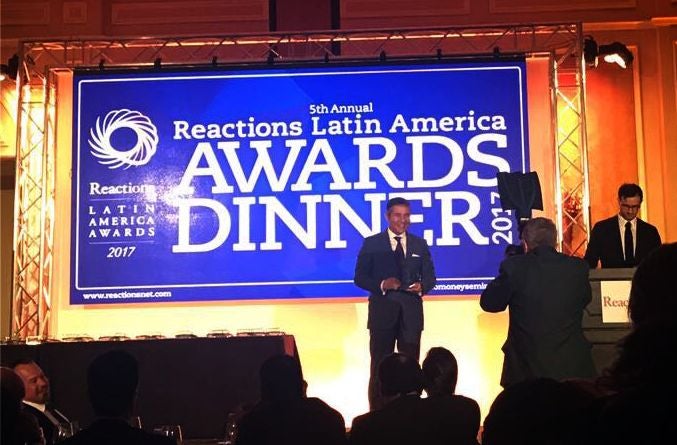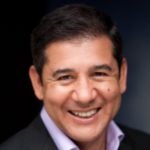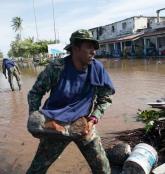It’s not as if a great evening at the Ritz-Carlton Coconut Grove in Miami with my peers and colleagues wasn’t special enough, but to collect the prize at the Reactions Latin America awards dinner for “Latin America Risk Modeler of the Year” was very special. I would like to personally thank the panel of judges who represent some of the leading figures in the region’s insurance and reinsurance market for the award.

It is always an honor to be recognized like this, but more importantly, what did we do to deserve this? What is RMS doing across Latin America to help the industry understand, quantify, and manage risk associated with natural and man-made perils. And what are we doing to achieve our wider mission, to address a growing “protection gap” across the region, and to build more resilient communities through innovative and sustainable change.
Looking at natural catastrophe perils, earthquakes represent the largest source of natural catastrophe loss in Latin America, and accounted for over US$90 billion in economic losses from 1970 to 2015 according to Swiss Re figures. Mexico is certainly a focus for potential earthquake losses, along with Chile, Ecuador, Peru, and Colombia. Swiss Re estimates that 88 percent of potential earthquake-induced losses are expected to go uninsured; the loss “gap” has grown from nearly 76 percent in 1980.
Mexico: Benefiting from Version 17 Investment
For Mexico, I am excited by the release of Version 17, as the RMS® Mexico Earthquake Model truly offers the latest scientific understanding of seismic hazard for the country. The model improves risk differentiation by incorporating new ground motion prediction equations for more accurate estimates of ground motion at specific locations, and offers an improved understanding of the geometry and event recurrence rates for the Mexico Subduction Zone.
Reflecting regional differences in construction design and practices in line with Mexico’s building and recently updated seismic codes, helps get model users closer to capturing different levels of vulnerability. For the updated Mexico City basin amplification model, vulnerability is focused on “micro-zones”, some at 100 meter resolution; zones first identified in the aftermath of the 1985 earthquake, as the seismic performance of similar buildings varied significantly, correlated with the soil properties of the building sites.
Exploring the South America Earthquake Model Suite
The RMS suite of South America Earthquake models covers Argentina, Bolivia, Brazil, Chile, Colombia, Ecuador, Peru, and Venezuela; combined the models provide the most comprehensive coverage for managing earthquake risk in all seismically active countries in South America. Based on a single region-wide catalog that includes more than 134,000 stochastic events, the models capture the influence of local soil conditions on earthquake shaking and incorporate local design and construction practices into assessments of building vulnerability.
RMS has received approval for the RMS® Peru Earthquake Model and the RMS® Colombia Earthquake Model by the superintendents of insurance in each country for use by local insurance companies in submitting their regulatory filings. This has broadened the choice of regulator-approved models for the firms operating in the region, as the regulators explore regulations similar to Solvency II in the European Union.
Effective Risk Differentiation for Hurricane
Floods and storms have been the most frequent perils in Latin America. For hurricane, Mexico, Central America, and the Caribbean all benefit from the extensive revisions and updates within the Version 17 RMS® North Atlantic Hurricane models, validated by over 20,000 wind and storm surge observations, over $300 billion in industry loss data, and more than $20 billion of location level claims and exposure data. The models support effective risk differentiation and selection decisions down to the local level within and across regions. The hazard component incorporates high-resolution (up to 15 meters) and high-quality satellite data, reflecting the most up-to-date land use and land cover information.
And new opportunities arise, such as the RMS® Marine Cargo model managing cargo and specie risk from wind, storm surge and/or earthquake, covering 47 Caribbean and Latin American countries. The model includes details on more than 2,000 combinations of transported products and how they are stored, packaged, and protected to provide a view of marine risk with unprecedented granularity.
Helping Support the Insurance Industry in Latin America
RMS wants to help insurers in the region to take full advantage of risk modeling developments and opportunities. Last year, RMS introduced a risk maturity benchmarking framework for the Latin America market to help insurers quantify their strengths and weakness for catastrophe risk management. RMS provides an actionable set of recommendations and an implementation plan for improvement linked directly to an insurers’ strategic initiatives.
Building Resilience in the Region
RMS is a longstanding global platform partner of Build Change, supporting the retrofitting of low income housing, currently working in Haiti, Colombia, Ecuador, and Peru. In collaboration with the Rockefeller Foundation, we partnered with several local governments in the region: in Mexico City, by evaluating the risk to key public facilities; in Medellin, Colombia, by assessing the cost-benefit of various retrofitting options; and in Santiago, Chile, by providing insight into the impacts of earthquake scenarios on the city.
We also developed a drought modeling application as part of a project with the German Government, the Natural Capital Finance Alliance and several leading financial institutions, including Banamex, Santander, and Banorte. The tool enables financial institutions to stress-test their lending portfolios against drought scenario events in several countries, including Mexico and Brazil.
Latin America offers huge growth opportunities for the insurance industry, and RMS is committed to help (re)insurers achieve their growth strategies. Please feel free to reach out to me.







